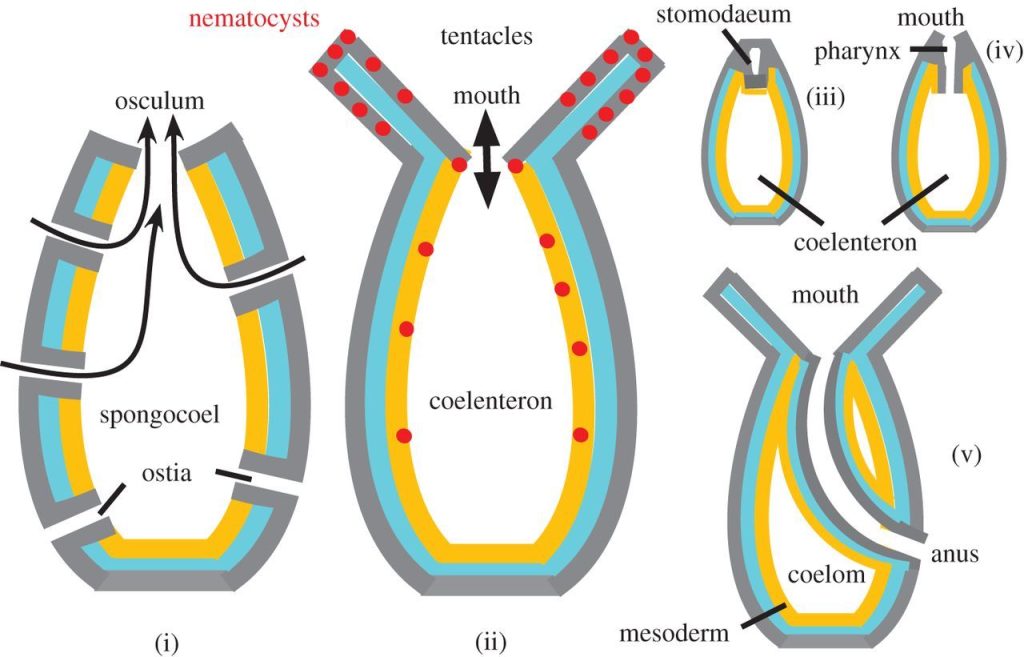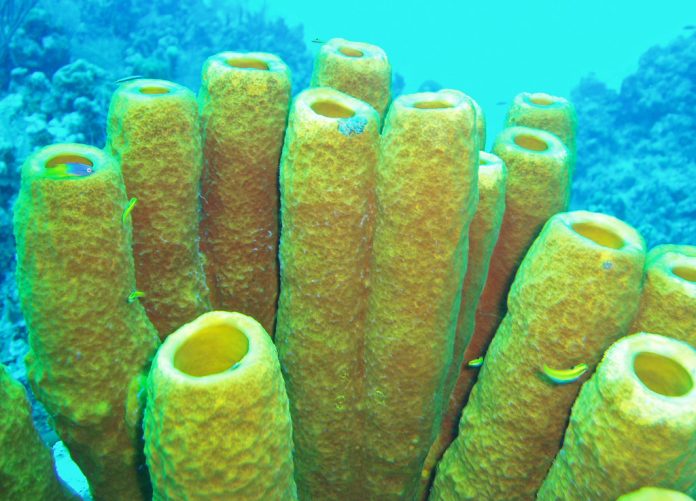CELL TYPES, BODY WALL, AND SKELETONS of Sponges
Sponges, despite their apparent simplicity, exhibit a complex cellular organisation. Their body is made up of specialised cells that perform distinct functions, showcasing a division of labour.
The outer layer of sponges is covered by pinacocytes, thin and flat cells that might slightly contract to influence the sponge’s shape. Within some sponges, certain pinacocytes evolve into porocytes, tube-like cells that regulate water flow through the sponge by contracting.
Beneath the outer layer is a jelly-like substance called the mesohyl, housing amoeboid mesenchyme cells. These cells are versatile, undertaking various roles such as reproduction, secreting skeletal elements, food transport and storage, and forming contractile rings around the sponge’s openings.

The inner chambers of sponges are lined with choanocytes, or collar cells, which are crucial for water filtration and feeding. These cells have a flagellum surrounded by a collar of microvilli, working together to create water currents and filter food particles from the water. The presence of choanocytes links sponges to choanoflagellates, highlighting an evolutionary connection.
Sponges possess a supportive skeleton made from spicules, microscopic spikes produced by amoeboid cells, composed of either calcium carbonate or silica. Alternatively, some sponges have skeletons made of spongin, a fibrous protein. The composition of the skeleton plays a vital role in classifying sponges.
BODY FORMS
The survival of sponges relies heavily on water currents generated by choanocytes, which provide them with oxygen and food while removing waste. Sponges exhibit three main body types—Ascon, Sycon, and Leucon—each with unique arrangements for water flow and filtration.
Asconoid sponges are the simplest, shaped like vases with water entering through outer openings (ostia) and exiting through a large opening (osculum) at the top.
Syconoid sponges feature a folded wall design, enhancing the surface area for filtration. Water travels through dermal pores into incurrent canals, then through radial canals lined with choanocytes, and finally exits through the osculum.
Leuconoid sponges have the most complex structure with an extensive canal system, maximizing the surface area for choanocytes and thus, filtration capacity. They lack a central cavity, and water exits through multiple oscula.

MAINTENANCE OF FUNCTIONS
Sponges feed on a variety of particles, from bacteria to small algae, using choanocytes to filter food from water. Some sponges are also capable of absorbing nutrients directly from seawater or ingesting larger particles through pinacocytes. Waste removal and gas exchange in sponges occur via diffusion due to their constant water flow.
Sponges lack nerve cells, with cellular responses often being the primary means of reacting to environmental changes. However, behaviors such as the synchronization of choanocyte activity suggest some form of internal communication, possibly through chemical signals or ion exchange across cell surfaces.
REPRODUCTION IN SPONGES
Sponges are mostly monoecious, with sexual reproduction involving the transformation of choanocytes into sperm and other cells into eggs. Fertilization occurs internally, with sperm entering through the incurrent water flow. Sponges also reproduce asexually, forming resistant structures called gemmules under unfavorable conditions, which can develop into new sponges when conditions improve.
Sponges have remarkable regenerative capabilities, able to reform individuals from fragmented pieces, demonstrating their resilience and adaptability.



[…] Flatworms are categorized into three primary classes based on their parasitic tendencies: Turbellaria, Trematoda, and Cestoda, with about 25,000 known species. Notable parasitic flatworms include the liver fluke, which resides in human and animal hosts, causing significant health issues like jaundice and liver damage, and the tapeworm, which possesses a unique body structure divided into the scolex, neck, and strobila. The tapeworm’s adaptation to a parasitic lifestyle is evident in its complete reliance on predigested nutrients from the host’s gut, facilitated by the absence of a digestive system and protected by a resilient cuticle. […]